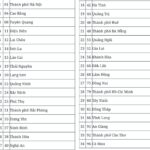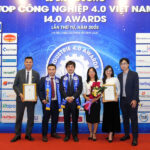On June 23, the Government Office issued Notification 315/TB-VPCP, concluding Deputy Prime Minister Nguyen Chi Dung’s meeting on the deployment of Plan No. 02-KH/BCDTW on science and technology development, innovation, and digital transformation.
The notification clearly states that the goals, key tasks, roadmap, and responsibilities of ministries, sectors, government agencies, and local authorities are well-defined in Plan No. 02-KH/BCDTW of the Central Steering Committee.
The Deputy Prime Minister instructed ministers, heads of ministerial agencies, and provincial/municipal People’s Committees to promptly and effectively implement Plan No. 02-KH/BCDTW according to their assigned functions and tasks.
They are also accountable to the Politburo, the Party Central Committee, the Government, and the Prime Minister for the progress and outcomes of the assigned tasks.
The Deputy Prime Minister assigned the Ministry of Public Security to take charge, in collaboration with relevant ministries and agencies, to develop and submit to the Government a resolution on promoting data creation to serve the comprehensive digital transformation, as directed by the Prime Minister.
Additionally, they are to develop and submit to the Prime Minister for approval a plan to integrate security and traffic surveillance camera systems into provincial-level smart control centers (IOCs) and interconnect them with the National Population Database. This integration should be based on the principle of inheritance and shared utilization of a unified platform.
The Ministry of Public Security is also responsible for upgrading the electronic identification and authentication system to provide identification accounts for foreigners and businesses with foreign elements, ensuring uninterrupted service from July 1, 2025.
The Deputy Prime Minister also assigned the Minister of Science and Technology, as the head of the Task Force for Science and Technology Development, Innovation, and Digital Transformation, to oversee tasks related to digital transformation.
The Ministry of Science and Technology, in coordination with the Ministry of Finance and relevant ministries and agencies, shall propose solutions to upgrade and expand the Specialized Data Transmission Network towards a centralized and unified network from the central to local levels. This network should be interconnected with agencies and organizations within the political system and completed by June 30, 2025.
The Ministry of Science and Technology, in collaboration with the Ministry of Finance, shall guide localities in establishing and operating smart control centers to ensure interconnection and effective exploitation of information and data for local socio-economic development.

Illustrative image
They shall also coordinate with localities to develop a plan to upgrade and adjust local administrative procedure handling systems, completing it by June 25, 2025.
The notification emphasizes that the Government Office shall complete the upgrade of the National Public Service Portal’s functions and coordinate with the People’s Committees of provinces and centrally-run cities to ensure smooth connectivity with the provincial-level administrative procedure handling systems. This is to meet the requirements of implementing the two-level local government model.
The interface of the Provincial Public Service Portal will be closed, and the National Public Service Portal will be officially tested from June 28, 2025, to ensure smooth operation from July 1, 2025. The Government Office shall also guide and urge localities to improve the quality of operations of the Provincial and District Public Service Centers.
Thus, the Provincial Public Service Portal will cease to operate from July 1, 2025, and the Ministerial Public Service Portal will no longer be operational by the end of February 2026.
Instead, all online public services in the 34 provinces and cities after the merger will be integrated and provided exclusively through the National Public Service Portal at dichvucong.gov.vn.
The National Public Service Portal becomes the sole “one-stop shop” nationwide. In June 2025, ministries, sectors, and localities must complete the integration and provision of 100% of online public services on the National Public Service Portal.
Expected administrative unit codes for the 34 provinces and cities after the merger
The Ministry of Finance is seeking opinions on the draft Decision of the Prime Minister on issuing the List and Codes of Administrative Units of Vietnam.
According to the Ministry of Finance, the new list and codes of administrative units will replace the old ones in Decision 124/2004.
The list and codes of administrative units are used for management, planning, and statistical purposes.
According to the recently passed National Assembly resolution on the merger of provincial-level administrative units in 2025, the number of provinces and cities nationwide will be reduced from 63 to 34, and the number of district-level and commune-level units will decrease from 10,035 to 3,321 after rearrangement. Therefore, the list and codes of administrative units in Vietnam need to be amended to align with the new structure.
The draft states that the list and codes of administrative units at the provincial level include 34 units coded with two digits. The list and codes of administrative units at the communal level comprise 3,321 units coded with four digits.

The draft arranges the coding of administrative units in a north-to-south and west-to-east order, with the boundary line at the northernmost point and in combination with the geographical region of each level as the basis for determination.
Within the country, Hanoi is ranked first, and the remaining provinces and cities are ranked according to the above principle. Within a province, the administrative unit where the People’s Committee is located is ranked first, followed by other units in the order of urban before rural, from north to south, and from west to east.
In cases where the provincial People’s Committee office remains in the old location, the codes of the administrative units at all levels remain unchanged. For a province with a new location for its People’s Committee office, it will be ranked accordingly, and new codes will be assigned. The codes of district-level and commune-level administrative units remain unchanged.
The draft also arranges codes based on the principle that in the case of a merger, the province where the People’s Committee office is located will bear its code, and the code of the other province will be closed and not reassigned to another administrative unit. The codes of district-level and commune-level administrative units in the merged province remain unchanged.
Similar principles apply to commune-level administrative units when there is a change in the location of the commune People’s Committee office.
In cases where administrative units at all levels change their names or switch from rural to urban areas or vice versa, the codes remain unchanged.
A Business Offers Free E-Invoicing Software for Small Businesses: Claim it Now!
“Small businesses will be thrilled to discover that they are eligible for a complete waiver of fees for a range of essential software tools. This includes electronic invoicing software initiated from cash registers, remote digital signatures, accounting software, and retail management software. These tools are invaluable assets for any small business, offering streamlined efficiency and effective management solutions.”
“Streamlining Administrative Codes: A Proposal for 34 Merged Provinces and Cities”
Introducing the dynamic trio of Vietnam’s metropolitan areas, each with their unique codes: Hanoi, with its sleek and sophisticated code of 01, sets the standard for the north. Moving down the coast, we have the enchanting Danang with code 48, a gateway to central Vietnam’s charm. And last but not least, the vibrant Ho Chi Minh City, coded as 79, pulses with energy in the south. These codes are more than just numbers; they represent the heartbeat of each city, reflecting their distinct character and allure.
The Ultimate Guide to Optimizing Your Administrative Units: Crafting a Lean, Mean, Efficient Machine
“Maintaining the number of provincial-level Vice Chairpersons during the transition period, providing guidance on administrative organization in special administrative regions with a population of under 1,000, and outlining procedures for merging and renaming villages and residential areas post-unification are among the key highlights of Official Dispatch No. 4168/BNV-CQDP issued by the Ministry of Home Affairs on June 23, 2025.”
“SHB’s Integrated Payment Solutions: A Presentation to Prime Minister Pham Minh Chinh.”
“As a prominent player in the banking industry, Saigon – Hanoi Commercial Joint Stock Bank (SHB) is proud to unveil its cutting-edge integrated payment solutions and a glimpse into the future of banking at the 2025 Digital Transformation in Banking event. SHB’s innovative offerings promise convenience and efficiency for administrative units, along with a revolutionary model for the Bank of the Future (BOF), showcasing its commitment to bringing transformative improvements to the financial landscape.”
The Digital Product Ecosystem of Meey Group Wins Consecutively at the Top Vietnam Industry 4.0 Awards.
On June 22nd, at the prestigious Industrie 4.0 Awards ceremony, Meey Land Joint Stock Company (Meey Group) excelled by clinching two significant awards. This remarkable feat cements their pioneering position in the digital transformation of the real estate industry, closely aligning with the nation’s strategic orientation and goals for digital evolution.














































